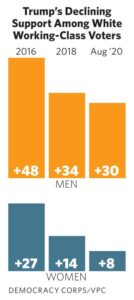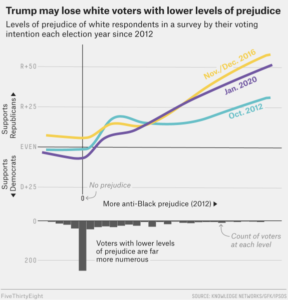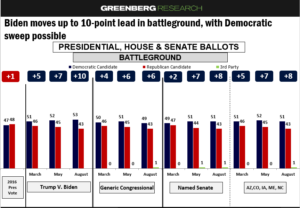In “How Trump Is Losing His Base: Focus groups with working-class and rural voters show the deep health care crisis in America, and trouble for Trump’s re-election,” Stanley B. Greenberg reports at The American Prospect:
The heartbreaking health care crisis that is ravaging working-class and rural communities threatens to cut short Donald Trump’s political career, and demands a forceful response from opposition Democrats. It will teach big lessons about how to reach working people who are struggling, regardless of color.
That is clear to me after listening to white working-class voters in Zoom focus groups for the American Federation of Teachers and Voter Participation Center in the first week of August, outside of metropolitan areas in rural Wisconsin, the Mahoning Valley region in Ohio (also known as Steel Valley), northern Maine, and suburban Macomb County, Michigan.
Greenberg notes that “The results of these sessions also fit with the results of a phone survey I conducted of working-class voters in the 16 battleground states,” and “The Republican House margin dropped 13 points across the white working class” in the 2018 midterm elections.

Greenberg calls the pandemic “the perfect storm,” and notes further,
I have never seen such a poignant discussion of the health and disability problems facing families and their children, the risks they faced at work, and the prospect of even higher health care and prescription drug costs. The final straw was a president who battled not for the “forgotten Americans,” but for himself, the top one percent, and the biggest, greediest companies.
That is why most in the Zoom focus groups pulled back from President Trump. Three-quarters of these voters supported Trump in 2016, but less than half planned to vote for him now. Even those who still supported him did not push back when other participants expressed anger with his doing nothing about health care, fostering hatred and racism, dividing the country, siding with the upper classes, and having no plan for COVID-19. This is a life-and-death issue for them, as much as nearly any other group in American society.
He adds that “Like lots of other working people, they are looking for a leader who will make big changes in health care, fight for working people over big business, and unite the country to defeat the current economic and public-health crisis.” In addition, “In today’s working-class, and rural communities, health care is everything. In introductory remarks, participants in the focus groups went right to the personal health care crises they were facing every day.”
Greenberg shares some statistics regarding the prevalence of helath disabilities in working-class communities, and explains,
Across the country, 12.6 percent of the population has disabilities, rising to 15.1 percent in rural areas. Black and Native American populations are more likely to have disabilities than their white counterparts. The rate is over a quarter for those 65 to 74 years old and half of those over 75 years—all groups that are overrepresented in these rural areas. And structural racism has played a powerful role here: 20 percent of Blacks with disabilities were employed at the beginning of this year, compared to 30 percent of whites and Hispanics with disabilities.
Then I looked at census data for the congressional districts where these sessions were being held. It was a new window into America in the pandemic. In suburban Macomb County, the disability rate looks like the rural areas, with 14 percent of both whites and Blacks disabled. In northern Maine, the numbers show one in five with disabilities, slightly more for whites. In Ohio’s Sixth Congressional District, both one in five whites and Blacks are disabled. And seniors in these areas are even more disabled than other rural Americans.
So COVID violently brought together the personal health crises of these people and the failed and corrupted government response, breaking their emotional bond with Trump.
Just throw out the words “health care,” and people relayed a train of horrors: a “$16,000 deductible,” employers throwing them off health insurance, “ridiculous” premiums, a $400 bill for their asthma medicine paid for out of pocket. They spoke of the frustrations of making too much money to be eligible for Medicaid but not enough to stay in the solid middle class. They explained how people avoid treatment because they can’t pay the associated costs. “The way we deliver health care is just unbelievable,” said one woman from Michigan, “the amount of waste and how much it costs to let people go bankrupt to pay for medical bills.”
While some of the respondents were critical of the shortcommings of the Affordable Care Act, they believe that Trump “failed to take the virus seriously and has just made a mess of it. They think he is failing at the most important issue for them…Respondents despaired about the lack of a national plan of action, with everyone “just left on their own.” Greenberg adds,
In emails we asked the participants to send to President Trump, you can feel that the spirit that led them to join the working-class revolt is just broken. While some hope he will get back in the right direction, most used their email to express their deep disillusionment. You can feel that they wanted a president who didn’t divide the country and make it a “laughingstock” (two writers used that exact word) internationally. They wanted a president who put the interests of the people, not just big business, first.
“I supported you in the beginning over Hillary but in the end unfortunately, you show me you’re just not for the people,” wrote one man from Wisconsin. “You lied to the American people about COVID,” wrote another. “You are everything that is wrong with America, you have effectively ruined this country,” added a woman from Ohio. “Congrats, you suck.”
Greenberg concludes, “COVID has shattered so many lives, but also seemingly insurmountable political barriers. The great majority of working people, regardless of color, are desperate for a government that stops taking direction from the pharmaceutical companies, and brings the boldest feasible changes to our health care system.”





